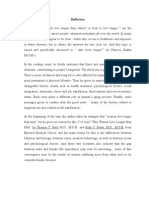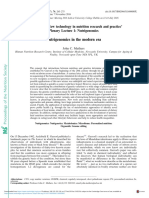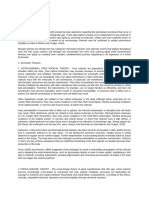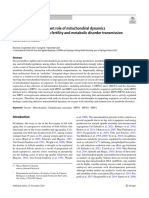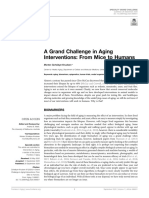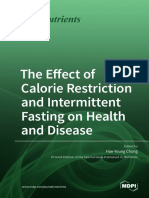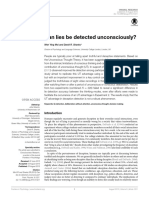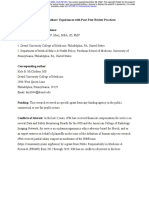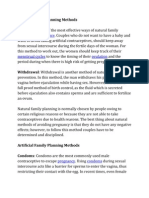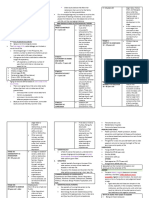Fragi 01 610406
Fragi 01 610406
Uploaded by
msCopyright:
Available Formats
Fragi 01 610406
Fragi 01 610406
Uploaded by
msOriginal Title
Copyright
Available Formats
Share this document
Did you find this document useful?
Is this content inappropriate?
Copyright:
Available Formats
Fragi 01 610406
Fragi 01 610406
Uploaded by
msCopyright:
Available Formats
SPECIALTY GRAND CHALLENGE
published: 16 November 2020
doi: 10.3389/fragi.2020.610406
The Promise of a Golden Era for
Exploring the Frontiers of Aging,
Metabolism and Redox Biology
Jianhua Zhang *
Department of Pathology, Center for Free Radical Biology, University of Alabama at Birmingham, Birmingham, AL, United States
Keywords: autophgy, mitophagy, diet, exercise, omics, bioenergetics, oxidative stress, comparative biology
From ancient times to the modern day extending longevity or even finding the elixir for eternal life
has been a motivating quest for many civilizations. There are no shortage of Hollywood films and TV
series that feature long-lived creatures: some heroes and others villains. Many of the ancient Greeks
have what we would regard as a normal lifespan (Montagu, 1994; Batrinos, 2008). For example,
Socrates before his untimely demise was in his 70s. Physicians had been directed to concoct potions
to extend the life of emperors and the wealthy. In the Qin Dynasty, the emperor sent 500 young men
and 500 young women to find the elixir of life in the legendary Penglai, the miraculous place of the
immortals. Detailed descriptions of medicines for immortality were written in the book “Essential
Formulas of Danjing Classics”. Some of these concoctions we would regard as remarkably toxic as
they contain mercury or arsenic. Interestingly, this quest for longevity continues unabated and has
now become a central pillar for modern health care. However, the perils persist with the unverified
claims of a broad range of supplements or the off-target effects of therapeutics which maybe toxic or
otherwise decrease longevity. Clearly, then as now an understanding of the fundamental biology and
chemistry of aging is an essential goal for modern scientific research.
Despite the long history of the fascination of a long life, aging research as a systematic scientific
effort is a recent affair. In the United States, the Aging Related Unit in the National Institutes of
Edited and reviewed by: Health was formed in the 1940s, first in the NIH Division of chemotherapy, then moved to Baltimore
Changhan David Lee, City Hospital under the direction of Nathan Shock. In 1974 the National Institute of Aging (NIA)
University of Southern California, Los became an independent institute with a focus on aging biology and age related diseases. PubMed
Angeles, United States documents publications on aging as early as in 1925. In 1988, the first genetic locus age-1 that
*Correspondence:
modulates lifespan was identified in C. elegans (Friedman and Johnson, 1988), and 8 years later
Jianhua Zhang cloned and found to encode a PI3 kinase (Morris et al., 1996). Now there are a total of ∼487,000
JianhuaZhang@uabmc.edu articles using the search term “Aging” in PubMed, with ∼20,000 articles since 2020.
There has also been a long-standing interest associating aging with metabolism. Searching
Specialty section: PubMed with “Aging and Metabolism” results in ∼188,685 articles, with 3,219 since 2020. Dietary
This article was submitted to Aging, restriction has been shown to affect longevity and age related illnesses in several organisms and
Metabolism and Redox Biology, model systems, with the effects on longevity dependent on genetic background (Mair et al., 2003;
a section of the journal Liao et al., 2010; Cava and Fontana, 2013). At the molecular level, extended lifespan has been
Frontiers in Aging
associated with insulin and IGF-1 receptor function, as well as age-1/PI3 kinase activity (Kenyon
Received: 25 September 2020 et al., 1993; Kimura et al., 1997). Modulation of sirtuins, which are NAD+ (Nicotinamide adenine
Accepted: 23 October 2020 dinucleotide) dependent enzymes, was reported to extend lifespan in yeast (Kennedy et al., 1995;
Published: 16 November 2020
Kaeberlein et al., 1999). AMPK (AMP activated protein kinase), a key sensor of metabolism and
Citation: cellular energy, is required for lifespan extension in C. elegans in response to dietary restriction
Zhang J (2020) The Promise of a
(Greer et al., 2007). Targeting the nutrient sensing pathway, the mTOR (mechanistic target of
Golden Era for Exploring the Frontiers
of Aging, Metabolism and
rapamycin) signaling pathway, using the inhibitor rapamycin, has been used to enhance longevity in
Redox Biology. several organisms, and shows efficacy when administered to aged mice (Harrison et al., 2009; Miller
Front. Aging 1:610406. et al., 2011; Papadopoli et al., 2019). These studies suggest that the aging can be modified by changes
doi: 10.3389/fragi.2020.610406 in lifestyle or pharmacological intervention.
Frontiers in Aging | www.frontiersin.org 1 November 2020 | Volume 1 | Article 610406
Zhang Frontier Aging – Metabolism & Redox Biology
Observations that a deficit of mitochondrial function may cellular context, may have contrasting effects on aging-
result in energy shortage and accumulation of reactive species dependent processes.
that are damaging to cellular structure and function inspired the In many aging related phenomena, including cellular
“Mitochondrial dysfunction theory of aging” (Lemasters, 2005; senescence and perturbation circadian control, inadequacy in
Payne and Chinnery, 2015; Kauppila et al., 2017). Paradoxically, the autophagy and mitophagy pathways, also have strong
there are also observations that inhibition of mitochondrial connection to redox and metabolic regulation (Lopez-Otin
respiration can extend lifespan. Reconciliation of these et al., 2013). Autophagy is an intracellular degradation process
observations leads to the concept that the plasticity of that is highly regulated by a variety of signals including
metabolic pathways, which has a preprogrammed genetic availability of metabolic substrates, cellular and the
component, is central in adapting to the environment and in environmental redox landscape (Zhang, 2015; Klionsky et al.,
turn impacts longevity (Kayser et al., 2004; Lapointe and Hekimi, 2016). It is now clear that autophagy is a pathway that may
2008; Copeland et al., 2009; Yang and Hekimi, 2010). This is an remove and reverse cellular damage caused by oxidative stress
idea captured in the “Hormesis theory of aging” (Ristow and and as such it is important to understand whether it is sufficiently
Schmeisser, 2014; Yun and Finkel, 2014). Clearly, the term active at the right place and at the right time (Lee et al., 2012;
“mitochondrial dysfunction” is inadequate to describe the Giordano et al., 2014). Because of its central importance in health,
complexity of the adaptive capacity of the age regulated disease and aging, the specific autophagic degradation of the
metabolic pathways. Additionally, a judicious inhibition of mitochondria was identified as a specific process known as
mitochondrial respiration may be required for activation of mitophagy (Lemasters, 2005; Redmann et al., 2014; Ma et al.,
survival pathways (Chouchani et al., 2013). A better 2020). Autophagy and mitophagy then play a key role in the
understanding of the role of metabolism in aging calls for quality control and turnover of lipids, proteins, and organelles,
more insights into the specifics of regulation of bioenergetics and their regulation modulates the metabolic and redox
and metabolism which is now becoming feasible with the advent landscape (Dodson et al., 2013; Redmann et al., 2016). In
of sensitive and high precision technologies in these areas of aging tissues and age related diseases, these processes are
research (Hill et al., 2019). unable to clear excess or dysfunctional proteins and organelles
Although that “the Free Radical Theory of Aging” was (Wong et al., 2020). Damaged organelles including mitochondria
proposed in 1956 based on the idea that free radicals can together with the accumulation of toxic proteins may further
attack cellular constituents and thus may be a direct cause for propagate cellular damage and contribute to the progression of
aging (Harman, 1956), research linking aging to redox age related diseases (Chen et al., 2020).
modulation is still evolving. With the realization that “free Aging research has been gaining momentum as better tools are
radicals” have a signaling role, it is clear that this basic developed and systems biology approaches are adopted. CRISPR/
hypothesis needs refinement to encompass new advances in Cas techniques provide enhanced means of determining
redox biology and the recognition that all “free radicals” are experimentally the functional consequence of gene disruption
not the same. Searching “Aging and Free Radical” has total of or mutation (Ran et al., 2013; Charpentier et al., 2019). These
13,754 articles, “Aging and oxidative stress” 19,044, “Aging and approaches can give insights into the networks that sense
Redox” 9,139 articles. Many studies have challenged the idea that environmental signals that change cellular functions and
cellular oxidative damage due to “free radicals” or oxidative stress thereby contributing to healthy aging or age related
is a cause of aging. First, reactive oxygen species (or ROS) may be pathologies. Genomics, transcriptomics, proteomics, and
important in modulating aging, but the hypothesis lacks precision metabolomics, some even at the single cell level, will aid in the
since it fails to identify “which species” contribute to aging or the understanding of the aging process in complex organs including
mechanisms involved. This point is sometimes over-looked but the brain and the immune system (Aon et al., 2020; Zhang et al.,
similarly if we say “Genes” and “Proteins” are important in 2020). High throughput bioenergetics analyses are now available
modulating aging, most of us will ask which gene(s) and which use small quantities of materials and even frozen samples
which protein(s). Fortunately, technical advances are over- and thus greatly extend the current studies of metabolism and its
coming these barriers and allow specific hypotheses to be connection to aging (Dranka et al., 2011; Hill et al., 2012; Chacko
tested. Over the last 10 years the genetic regulation of redox et al., 2014; Redmann et al., 2018; Acin-Perez et al., 2020). For
related networks has also turned out to be remarkably complex. example, recent studies substantiated the connection of
For example, one of the key regulators of redox modulatory mitochondrial function, metabolism inflammation, and aging,
proteins is Nrf2, which is a transcription factor that regulates and revealed the potential for a better understanding of this
genes encoding a subset of redox regulatory proteins, and is also a integrated regulatory network in attenuating age related diseases
downstream target of insulin receptor and involved in lifespan and promoting healthy aging (Bernard et al., 2018; Dunham-
regulation in C. elegans (Tullet et al., 2008). What is not predicted Snary et al., 2018; Rangarajan et al., 2018). In addition, a better
from the “Free radical theory of aging” is that increased understanding of the fundamentals of redox biology, and the
expression of Nrf2 and its target antioxidant enzymes is improvement of techniques detecting and scavenging different
detrimental for health and disease (Rajasekaran et al., 2011; reactive species are resulting in a rapid evolution of redox biology
Levonen et al., 2014; Dodson et al., 2015; Schmidlin et al., research (Kalyanaraman et al., 2012; Kalyanaraman, 2013;
2019). This key finding indicates that both “oxidative” and Afonso and Spickett, 2019). Advanced informatics methods
“reductive” stress, depending on their specificity, levels and have been developed, including GWAS, NetWAS, the
Frontiers in Aging | www.frontiersin.org 2 November 2020 | Volume 1 | Article 610406
Zhang Frontier Aging – Metabolism & Redox Biology
transcriptome-metabolome-wide association study (TMWAS) involved in modifying lifespan are complex, and may be
and xMWAS platforms. These methods facilitate data dependent on genetic, environmental, age, and other as yet
integration, network visualization, clustering and differential unknown factors (Longo and Panda, 2016; Radak et al., 2019;
network analyses of data from two or more omics dataset of Kepp et al., 2020; Perez-Matos & Mair, 2020). Pharmacological
genetic phenotypic, biochemical, or cell biological assays, which reagents that target autophagy and mitophagy can be tested and
can reveal the whole organism changes that underlie the biology optimized against age related diseases and promote healthy
of aging (Beekman et al., 2013; Go et al., 2018; Uppal et al., 2018; aging (Galluzzi et al., 2017; Piskovatska et al., 2019).
Chacko et al., 2019; Roussarie et al., 2020; Smith et al., 2020). Compounds targeting the mitochondria, for example, MitoQ,
Integration of metabolism, redox biology with aging phenotypes and SS-31 have been explored for their potential for healthspan
will likely reveal novel nodes of regulation which can then identify enhancement (Tate et al., 2019; Young & Franklin, 2019;
new targets for healthspan extension interventions. Whitson et al., 2020). Senolytics have been shown to
It is important to recognize that aging is not a single organ attenuate cell-free mitochondrial DNA release, which then
disease, and is highly dependent on the fact that tissues decreases the detrimental immune responses associated with
functionally interact and cross modulate. The blood and aging (Iske et al., 2020). Mitochondria not only can be targeted
lymph circulate through the body and transport hormones, to improve metabolism and healthspan, but also can generate
nutrients, cytokines, myokines, cell-free mitochondrial DNA, the mitochondrial-derived peptides (MDPs) that can regulate
and other cellular metabolic products to other parts of the body metabolism and health (Reynolds et al., 2020).
(Barron and Pike, 2012; Coelho et al., 2019; Cunnane et al., Advancement of hygiene, food and environmental safety,
2020; Iske et al., 2020). Aging associated accumulation of the health care, and a better understanding of aging biology and
propionate metabolism product methylmalonic acid in the aging interventions are at such a stage that it has been suggest
serum, may reprogram cancer cells to become more that the individuals who will reach the age of 150 are already living
aggressive (Gomes et al., 2020). The microbiome contributes (https://www.stevenaustad.com/). It is still not clear why age is the
to a large portion of the total DNA/RNA in mammals and single most important risk factor for many diseases including but
controls metabolism through its interaction with the diet and not limited to: cancer, cardiovascular and neurodegenerative
other environmental factors (Bernard et al., 2018; Bana and diseases. This is a new exciting era in which enabling
Cabreiro, 2019; Buford, 2020). Bacterial and viral infection, technologies can provide exciting new insights into the
also alters the biology of the body and impact aging and age mechanisms and biology of aging. It is likely that research
related diseases (Szaniawski and Spivak, 2020). Thus linking aging to metabolism and redox regulation will feature
understanding the crosstalk between the gut, brain, liver, prominently in the next decade. The grand challenge is then to
heart and muscle via the circulation is of critical importance understand the networks linking metabolism, and redox biology to
to the understanding of aging biology (Lehallier et al., 2019). cell aging and organismal aging and to target specific metabolic and
Since we cannot view age related pathologies only in isolated redox networks for the promotion of a healthy lifespan.
cells or tissue, we can also learn by observing nature. The
existence of long-lived and short-lived species, for example, the
naked mole-rat, different varieties of fish, clams, turtles,
rodents, and centenarian humans, surely hold important
AUTHOR CONTRIBUTIONS
clues to understanding how longevity and healthy living The author confirms being the sole contributor of this work and
have been achieved (Austad, 2018). has approved it for publication.
An important contemporary research goal is to convert what
we understand about metabolism and redox regulation in the
context of aging into approaches to promote healthy aging. This
approach can be surprisingly straight forward. For example, it
ACKNOWLEDGMENTS
has been shown that supplementation of mitochondrial TCA The author thanks the UAB NSC P30 AG05886 and its faculties
cycle metabolites, malate, fumarate, alpha-ketoglutarate, and for discussions.
oxaloacetate, supplementation of NAD+ precursor
nicotinamide riboside extended lifespan in Drosophila and C.
elegans (Belenky et al., 2007; Williams et al., 2009; Edwards REFERENCES
et al., 2013; Chin et al., 2014; Zhang et al., 2016).
Supplementation of alpha-ketoglutarate also decreases Acin-Perez, R., Benador, I. Y., Petcherski, A., Veliova, M., Benavides, G. A., Lagarrigue,
S., et al. (2020). A novel approach to measure mitochondrial respiration in frozen
inflammation and frailty in mice, even when started at biological samples. EMBO J., 39, e104073. doi:10.15252/embj.2019104073.
18 months of age (Asadi Shahmirzadi et al., 2020). Not Afonso, C. B., and Spickett, C. M. (2019). Lipoproteins as targets and markers of
surprisingly, not all TCA cycle metabolites have the same lipoxidation. Redox Biol. 23, 101066. doi:10.1016/j.redox.2018.101066.
effects. For example, accumulation of succinate is detrimental Aon, M. A., Bernier, M., Mitchell, S. J., Di Germanio, C., Mattison, J. A., Ehrlich, M.
in the context of ischemia-reperfusion injuries (Chouchani R., et al. (2020). Untangling determinants of enhanced health and lifespan
through a multi-omics approach in mice. Cell Metabol. 32 (1), 100–116. doi:10.
et al., 2014). Dietary restriction, exercise, and circadian 1016/j.cmet.2020.04.018.
regulation have all been explored both in terms of metabolic Asadi Shahmirzadi, A., Edgar, D., Liao, C.-Y., Hsu, Y.-M., Lucanic, M., Asadi
mechanisms and with regard to reactive species. The networks Shahmirzadi, A., et al. (2020). Alpha-ketoglutarate, an endogenous metabolite,
Frontiers in Aging | www.frontiersin.org 3 November 2020 | Volume 1 | Article 610406
Zhang Frontier Aging – Metabolism & Redox Biology
extends lifespan and compresses morbidity in aging mice. Cell Metabol. 32 (3), Dranka, B. P., Benavides, G. A., Diers, A. R., Giordano, S., Zelickson, B. R., Reily, C.,
447–456. doi:10.1016/j.cmet.2020.08.004. et al. (2011). Assessing bioenergetic function in response to oxidative stress by
Austad, S. N. (2018). The comparative biology of mitochondrial function and the metabolic profiling. Free Radic. Biol. Med. 51 (9), 1621–1635. doi:10.1016/j.
rate of aging. Integr. Comp. Biol. 58 (3), 559–566. doi:10.1093/icb/icy068. freeradbiomed.2011.08.005.
Bana, B., and Cabreiro, F. (2019). The microbiome and aging. Annu. Rev. Genet. 53, Dunham-Snary, K. J., Sandel, M. W., Sammy, M. J., Westbrook, D. G., Xiao,
239–261. doi:10.1146/annurev-genet-112618-043650. R., McMonigle, R. J., et al. (2018). Mitochondrial - nuclear genetic
Barron, A. M., and Pike, C. J. (2012). Sex hormones, aging, and Alzheimer’s disease. interaction modulates whole body metabolism, adiposity and gene
Front. Biosci. 4, 976–997. expression in vivo. EBioMedicine 36, 316–328. doi:10.1016/j.ebiom.
Batrinos, M. (2008). The length of life and eugeria in classical Greece. Herpetol. 2018.08.036.
Assoc. Afr. J. 7 (1), 82–83. doi:10.14310/horm.2002.1111041. Edwards, C. B., Copes, N., Brito, A. G., Canfield, J., and Bradshaw, P. C. (2013).
Beekman, M., Blanché, H., Perola, M., Hervonen, A., Bezrukov, V., Sikora, E., et al. Malate and fumarate extend lifespan in Caenorhabditis elegans. PLoS One. 8
(2013). Genome-wide linkage analysis for human longevity: genetics of healthy (3), e58345. doi:10.1371/journal.pone.0058345.
aging study. Aging Cell. 12 (2), 184–193. doi:10.1111/acel.12039. Friedman, D. B., and Johnson, T. E. (1988). A mutation in the age-1 gene in
Belenky, P., Racette, F. G., Bogan, K. L., McClure, J. M., Smith, J. S., and Brenner, C. Caenorhabditis elegans lengthens life and reduces hermaphrodite fertility.
(2007). Nicotinamide riboside promotes Sir2 silencing and extends lifespan via Genetics 118 (1), 75–86.
Nrk and Urh1/Pnp1/Meu1 pathways to NAD+. Cell 129 (3), 473–484. doi:10. Galluzzi, L., Bravo-San Pedro, J. M., Levine, B., Green, D. R., and Kroemer, G.
1016/j.cell.2007.03.024. (2017). Pharmacological modulation of autophagy: therapeutic potential and
Bernard, K., Logsdon, N. J., Benavides, G. A., Sanders, Y., Zhang, J., Darley-Usmar, persisting obstacles. Nat. Rev. Drug Discov. 16 (7), 487–511. doi:10.1038/nrd.
V. M., et al. (2018). Glutaminolysis is required for transforming growth factor- 2017.22.
β1-induced myofibroblast differentiation and activation. J. Biol. Chem. 293 (4), Giordano, S., Darley-Usmar, V., and Zhang, J. (2014). Autophagy as an essential
1218–1228. doi:10.1074/jbc.ra117.000444. cellular antioxidant pathway in neurodegenerative disease. Redox Biol. 2, 82–90.
Buford, T. W. (2020). The gut microbiome and aging. J. Gerontol. A Biol. Sci. Med. doi:10.1016/j.redox.2013.12.013.
Sci. 75 (7), 1229–1231. doi:10.1093/gerona/glaa103. Go, Y.-M., Fernandes, J., Hu, X., Uppal, K., and Jones, D. P. (2018). Mitochondrial
Cava, E., and Fontana, L. (2013). Will calorie restriction work in humans? Aging 5 network responses in oxidative physiology and disease. Free Radic. Biol. Med.
(7), 507–514. doi:10.18632/aging.100581. 116, 31–40. doi:10.1016/j.freeradbiomed.2018.01.005.
Chacko, B. K., Kramer, P. A., Ravi, S., Benavides, G. A., Mitchell, T., Dranka, B. P., Gomes, A. P., Ilter, D., Low, V., Endress, J. E., Fernández-García, J., Rosenzweig, A.,
et al. (2014). The bioenergetic health index: a new concept in mitochondrial et al. (2020). Age-induced accumulation of methylmalonic acid promotes
translational research. Clin. Sci. 127 (6), 367–373. doi:10.1042/cs20140101. tumour progression. Nature 585 (7824), 283–287. doi:10.1038/s41586-020-
Chacko, B. K., Smith, M. R., Johnson, M. S., Benavides, G., Culp, M. L., Pilli, J., et al. 2630-0.
(2019). Mitochondria in precision medicine; linking bioenergetics and Greer, E. L., Dowlatshahi, D., Banko, M. R., Villen, J., Hoang, K., Blanchard, D.,
metabolomics in platelets. Redox Biol. 22, 101165. doi:10.1016/j.redox.2019. et al. (2007). An AMPK-FOXO pathway mediates longevity induced by a novel
101165. method of dietary restriction in C. elegans. Curr. Biol. 17 (19), 1646–1656.
Charpentier, E., Elsholz, A., and Marchfelder, A. (2019). CRISPR-Cas: more than doi:10.1016/j.cub.2007.08.047.
ten years and still full of mysteries. RNA Biol. 16 (4), 377–379. doi:10.1080/ Harman, D. (1956). Aging: a theory based on free radical and radiation chemistry.
15476286.2019.1591659. J. Gerontol. 11 (3), 298–300. doi:10.1093/geronj/11.3.298.
Chen, G., Kroemer, G., and Mitophagy, K. O. (2020). Mitophagy: An emerging role Harrison, D. E., Strong, R., Sharp, Z. D., Nelson, J. F., Astle, C. M., Flurkey, K., et al.
in aging and age-associated diseases. Front. Cell Dev. Biol. 8, 200. doi:10.3389/ (2009). Rapamycin fed late in life extends lifespan in genetically heterogeneous
fcell.2020.00200. mice. Nature 460 (7253), 392–395. doi:10.1038/nature08221.
Chin, R. M., Fu, X., Pai, M. Y., Vergnes, L., Hwang, H., Deng, G., et al. (2014). The Hill, B. G., Benavides, G. A., Lancaster, J. R., Jr., Ballinger, S., Dell’Italia, L., Zhang,
metabolite α-ketoglutarate extends lifespan by inhibiting ATP synthase and J., et al. (2012). Integration of cellular bioenergetics with mitochondrial quality
TOR. Nature 510 (7505), 397–401. doi:10.1038/nature13264. control and autophagy. Biol. Chem. 393 (12), 1485–1512. doi:10.1515/hsz-
Chouchani, E. T., Methner, C., Nadtochiy, S. M., Logan, A., Pell, V. R., Ding, 2012-0198.
S., et al. (2013). Cardioprotection by S-nitrosation of a cysteine switch on Hill, B. G., Shiva, S., Ballinger, S., Zhang, J., and Darley-Usmar, V. M. (2019).
mitochondrial complex I. Nat. Med. 19 (6), 753–759. doi:10.1038/nm. Bioenergetics and translational metabolism: implications for genetics,
3212. physiology and precision medicine. Biol. Chem. 401 (1), 3–29. doi:10.1515/
Chouchani, E. T., Pell, V. R., Gaude, E., Aksentijević, D., Sundier, S. Y., Robb, E. L., hsz-2019-0268.
et al. (2014). Ischaemic accumulation of succinate controls reperfusion injury Iske, J., Seyda, M., Heinbokel, T., Maenosono, R., Minami, K., Nian, Y., et al. (2020).
through mitochondrial ROS. Nature 515 (7527), 431–435. doi:10.1038/ Senolytics prevent mt-DNA-induced inflammation and promote the survival of
nature13909. aged organs following transplantation. Nat. Commun. 11 (1), 4289. doi:10.
Coelho, H. J., Jr., Picca, A., Calvani, R., Uchida, M. C., and Marzetti, E. (2019). If my 1038/s41467-020-18039-x.
muscle could talk: myokines as a biomarker of frailty. Exp. Gerontol. 127, Kaeberlein, M., McVey, M., and Guarente, L. (1999). The SIR2/3/4 complex
110715. doi:10.1016/j.exger.2019.110715. and SIR2 alone promote longevity in Saccharomyces cerevisiae by two
Copeland, J. M., Cho, J., Lo, T., Jr., Hur, J. H., Bahadorani, S., Arabyan, T., et al. different mechanisms. Gene Dev. 13 (19), 2570–2580. doi:10.1101/gad.13.
(2009). Extension of Drosophila life span by RNAi of the mitochondrial 19.2570.
respiratory chain. Curr. Biol. 19 (19), 1591–1598. doi:10.1016/j.cub.2009.08. Kalyanaraman, B., Darley-Usmar, V., Davies, K. J. A., Dennery, P. A., Forman, H.
016. J., Grisham, M. B., et al. (2012). Measuring reactive oxygen and nitrogen species
Cunnane, S. C., Trushina, E., Morland, C., Prigione, A., Casadesus, G., Andrews, Z. with fluorescent probes: challenges and limitations. Free Radic. Biol. Med. 52
B., et al. (2020). Brain energy rescue: an emerging therapeutic concept for (1), 1–6. doi:10.1016/j.freeradbiomed.2011.09.030.
neurodegenerative disorders of ageing. Nat. Rev. Drug Discov. 19 (9), 609–633. Kalyanaraman, B. (2013). Teaching the basics of redox biology to medical and
doi:10.1038/s41573-020-0072-x. graduate students: oxidants, antioxidants and disease mechanisms. Redox Biol.
Dodson, M., Darley-Usmar, V., and Zhang, J. (2013). Cellular metabolic and 1 (1), 244–257. doi:10.1016/j.redox.2013.01.014.
autophagic pathways: traffic control by redox signaling. Free Radic. Biol. Med. Kauppila, T. E. S., Kauppila, J. H. K., and Larsson, N.-G. (2017). Mammalian
63, 207–221. doi:10.1016/j.freeradbiomed.2013.05.014. mitochondria and aging: an update. Cell Metabol. 25 (1), 57–71. doi:10.1016/j.
Dodson, M., Redmann, M., Rajasekaran, N. S., Darley-Usmar, V., and Zhang, J. cmet.2016.09.017.
(2015). KEAP1-NRF2 signalling and autophagy in protection against oxidative Kayser, E.-B., Sedensky, M. M., Morgan, P. G., and Hoppel, C. L. (2004).
and reductive proteotoxicity. Biochem. J. 469 (3), 347–355. doi:10.1042/ Mitochondrial oxidative phosphorylation is defective in the long-lived
bj20150568. mutantclk-1. J. Biol. Chem. 279 (52), 54479–54486. doi:10.1074/jbc.m403066200.
Frontiers in Aging | www.frontiersin.org 4 November 2020 | Volume 1 | Article 610406
Zhang Frontier Aging – Metabolism & Redox Biology
Kennedy, B. K., Austriaco, N. R., Jr., Zhang, J., and Guarente, L. (1995). Mutation in Piskovatska, V., Strilbytska, O., Koliada, A., Vaiserman, A., and Lushchak, O.
the silencing gene S/R4 can delay aging in S. cerevisiae. Cell 80 (3), 485–496. (2019). Health benefits of anti-aging drugs. Subcell. Biochem. 91, 339–392.
doi:10.1016/0092-8674(95)90499-9. doi:10.1007/978-981-13-3681-2_13.
Kenyon, C., Chang, J., Gensch, E., Rudner, A., and Tabtiang, R. (1993). A C. elegans Radak, Z., Torma, F., Berkes, I., Goto, S., Mimura, T., Posa, A., et al. (2019).
mutant that lives twice as long as wild type. Nature 366 (6454), 461–464. doi:10. Exercise effects on physiological function during aging. Free Radic. Biol. Med.
1038/366461a0. 132, 33–41. doi:10.1016/j.freeradbiomed.2018.10.444.
Kepp, O., Chen, G., Carmona-Gutierrez, D., Madeo, F., and Kroemer, G. (2020). A Rajasekaran, N. S., Varadharaj, S., Khanderao, G. D., Davidson, C. J., Kannan, S.,
discovery platform for the identification of caloric restriction mimetics with Firpo, M. A., et al. (2011). Sustained activation of nuclear erythroid 2-related
broad health-improving effects. Autophagy 16 (1), 188–189. doi:10.1080/ factor 2/antioxidant response element signaling promotes reductive stress in the
15548627.2019.1688984. human mutant protein aggregation cardiomyopathy in mice. Antioxidants
Kimura, K. D., Tissenbaum, H. A., Liu, Y., and Ruvkun, G. (1997). daf-2, an Redox Sig. 14 (6), 957–971. doi:10.1089/ars.2010.3587.
insulin receptor-like gene that regulates longevity and diapause in Ran, F. A., Hsu, P. D., Wright, J., Agarwala, V., Scott, D. A., and Zhang, F. (2013).
Caenorhabditis elegans. Science 277 (5328), 942–946. doi:10.1126/science. Genome engineering using the CRISPR-Cas9 system. Nat. Protoc. 8 (11),
277.5328.942. 2281–2308. doi:10.1038/nprot.2013.143.
Klionsky, D. J., Abdelmohsen, K., Abe, A., Abedin, M. J., Abeliovich, H., Acevedo, Rangarajan, S., Bone, N. B., Zmijewska, A. A., Jiang, S., Park, D. W., Bernard, K.,
A. A., et al. (2016). Guidelines for the use and interpretation of assays for et al. (2018). Metformin reverses established lung fibrosis in a bleomycin model.
monitoring autophagy (3rd edition). Autophagy 12 (1), 1–222. doi:10.1080/ Nat. Med. 24 (8), 1121–1127. doi:10.1038/s41591-018-0087-6.
15548627.2016.1139264. Redmann, M., Dodson, M., Boyer-Guittaut, M., Darley-Usmar, V., and Zhang, J.
Lapointe, J., and Hekimi, S. (2008). Early mitochondrial dysfunction in long- (2014). Mitophagy mechanisms and role in human diseases. Int. J. Biochem. Cell
livedMclk1+/–mice. J. Biol. Chem. 283 (38), 26217–26227. doi:10.1074/jbc. Biol. 53, 127–133. doi:10.1016/j.biocel.2014.05.010.
m803287200. Redmann, M., Darley-Usmar, V., and Zhang, J. (2016). The role of autophagy,
Lee, J., Giordano, S., and Zhang, J. (2012). Autophagy, mitochondria and oxidative mitophagy and lysosomal functions in modulating bioenergetics and survival in
stress: cross-talk and redox signalling. Biochem. J. 441 (2), 523–540. doi:10. the context of redox and proteotoxic damage: implications for
1042/bj20111451. neurodegenerative diseases. Aging Dis. 7 (2), 150–162. doi:10.14336/ad.2015.
Lehallier, B., Gate, D., Schaum, N., Nanasi, T., Lee, S. E., Yousef, H., et al. (2019). 0820.
Undulating changes in human plasma proteome profiles across the lifespan. Redmann, M., Benavides, G. A., Wani, W. Y., Berryhill, T. F., Ouyang, X., Johnson,
Nat. Med. 25 (12), 1843–1850. doi:10.1038/s41591-019-0673-2. M. S., et al. (2018). Methods for assessing mitochondrial quality control
Lemasters, J. J. (2005). Selective mitochondrial autophagy, or mitophagy, as a mechanisms and cellular consequences in cell culture. Redox Biol. 17,
targeted defense against oxidative stress, mitochondrial dysfunction, and aging. 59–69. doi:10.1016/j.redox.2018.04.005.
Rejuvenation Res. 8 (1), 3–5. doi:10.1089/rej.2005.8.3. Reynolds, J. C., Bwiza, C. P., and Lee, C. (2020). Mitonuclear genomics and aging.
Levonen, A.-L., Hill, B. G., Kansanen, E., Zhang, J., and Darley-Usmar, V. M. Hum. Genet. 139 (3), 381–399. doi:10.1007/s00439-020-02119-5.
(2014). Redox regulation of antioxidants, autophagy, and the response to stress: Ristow, M., and Schmeisser, K. (2014). Mitohormesis: promoting health and
implications for electrophile therapeutics. Free Radic. Biol. Med. 71, 196–207. lifespan by increased levels of reactive oxygen species (ROS). Dose Response.
doi:10.1016/j.freeradbiomed.2014.03.025. 12 (2), 288–341. doi:10.2203/dose-response.13-035.ristow.
Liao, C.-Y., Rikke, B. A., Johnson, T. E., Diaz, V., and Nelson, J. F. (2010). Genetic Roussarie, J.-P., Yao, V., Rodriguez-Rodriguez, P., Oughtred, R., Rust, J., Plautz, Z.,
variation in the murine lifespan response to dietary restriction: from life et al. (2020). Selective neuronal vulnerability in Alzheimer’s disease: a network-
extension to life shortening. Aging Cell. 9 (1), 92–95. doi:10.1111/j.1474- based analysis. Neuron 107 (5), 821–835. doi:10.1016/j.neuron.2020.06.010.
9726.2009.00533.x. Schmidlin, C. J., Dodson, M. B., Madhavan, L., and Zhang, D. D. (2019). Redox
Longo, V. D., and Panda, S. (2016). Fasting, circadian rhythms, and time-restricted regulation by NRF2 in aging and disease. Free Radic. Biol. Med. 134, 702–707.
feeding in healthy lifespan. Cell Metabol. 23 (6), 1048–1059. doi:10.1016/j.cmet. doi:10.1016/j.freeradbiomed.2019.01.016.
2016.06.001. Smith, M. R., Chacko, B. K., Johnson, M. S., Benavides, G. A., Uppal, K., Go, Y.-M.,
López-Otín, C., Blasco, M. A., Partridge, L., Serrano, M., and Kroemer, G. (2013). et al. (2020). A precision medicine approach to defining the impact of
The hallmarks of aging. Cell 153 (6), 1194–1217. doi:10.1016/j.cell.2013.05.039. doxorubicin on the bioenergetic-metabolite interactome in human platelets.
Ma, X., McKeen, T., Zhang, J., and Ding, W. X. (2020). Role and mechanisms of Redox Biol. 28, 101311. doi:10.1016/j.redox.2019.101311.
mitophagy in liver diseases. Cells 9 (4), 837. doi:10.3390/cells9040837. Szaniawski, M. A., and Spivak, A. M. (2020). Senotherapeutics for HIV and aging.
Mair, W., Goymer, P., Pletcher, S. D., and Partridge, L. (2003). Demography of Curr. Opin. HIV AIDS. 15 (2), 83–93. doi:10.1097/coh.0000000000000609.
dietary restriction and death in Drosophila. Science 301 (5640), 1731–1733. Tate, M., Higgins, G. C., De Blasio, M. J., Lindblom, R., Prakoso, D., Deo, M., et al.
doi:10.1126/science.1086016. (2019). The mitochondria-targeted methylglyoxal sequestering compound,
Miller, R. A., Harrison, D. E., Astle, C. M., Baur, J. A., Boyd, A. R., de Cabo, R., et al. MitoGamide, is cardioprotective in the diabetic heart. Cardiovasc. Drugs
(2011). Rapamycin, but not resveratrol or simvastatin, extends life span of Ther. 33 (6), 669–674. doi:10.1007/s10557-019-06914-9.
genetically heterogeneous mice. J. Gerontol. A Biol. Sci. Med. Sci. 66A, 191–201. Tullet, J. M. A., Hertweck, M., An, J. H., Baker, J., Hwang, J. Y., Liu, S., et al.
doi:10.1093/gerona/glq178. (2008). Direct inhibition of the longevity-promoting factor SKN-1 by insulin-
Montagu, J. D. (1994). Length of life in the ancient world: a controlled study. J. R. like signaling in C. elegans. Cell 132 (6), 1025–1038. doi:10.1016/j.cell.2008.
Soc. Med. 87 (1), 25–26. 01.030.
Morris, J. Z., Tissenbaum, H. A., and Ruvkun, G. (1996). A phosphatidylinositol-3- Uppal, K., Ma, C., Go, Y.-M., Jones, D. P., and Wren, J. (2018). xMWAS: a data-
OH kinase family member regulating longevity and diapause in Caenorhabditis driven integration and differential network analysis tool. Bioinformatics 34 (4),
elegans. Nature 382 (6591), 536–539. doi:10.1038/382536a0. 701–702. doi:10.1093/bioinformatics/btx656.
Papadopoli, D., Boulay, K., Kazak, L., Pollak, M., Mallette, F., Topisirovic, I., et al. Whitson, J. A., Bitto, A., Zhang, H., Sweetwyne, M. T., Coig, R., Bhayana, S., et al.
(2019). mTOR as a central regulator of lifespan and aging. F1000Res 8, 25–26. (2020). SS-31 and NMN: two paths to improve metabolism and function in
doi:10.12688/f1000research.17196.1 aged hearts. Aging Cell. 19, e13213. doi:10.1111/acel.13213.
Payne, B. A. I., and Chinnery, P. F. (2015). Mitochondrial dysfunction in aging: Williams, D. S., Cash, A., Hamadani, L., and Diemer, T. (2009). Oxaloacetate
much progress but many unresolved questions. Biochim. Biophys. Acta supplementation increases lifespan inCaenorhabditis elegansthrough an
Bioenerg. 1847 (11), 1347–1353. doi:10.1016/j.bbabio.2015.05.022. AMPK/FOXO-dependent pathway. Aging Cell. 8 (6), 765–768. doi:10.1111/j.
Perez-Matos, M. C., and Mair, W. B. (2020). Predicting longevity responses to 1474-9726.2009.00527.x.
dietary restriction: a stepping stone toward precision geroscience. PLoS Genet. Wong, S. Q., Kumar, A. V., Mills, J., and Lapierre, L. R. (2020). Autophagy in aging
16 (7), e1008833. doi:10.1371/journal.pgen.1008833. and longevity. Hum. Genet. 139 (3), 277–290. doi:10.1007/s00439-019-02031-7.
Frontiers in Aging | www.frontiersin.org 5 November 2020 | Volume 1 | Article 610406
Zhang Frontier Aging – Metabolism & Redox Biology
Yang, W., and Hekimi, S. (2010). Two modes of mitochondrial dysfunction lead Zhang, J. (2015). Teaching the basics of autophagy and mitophagy to redox
independently to lifespan extension in Caenorhabditis elegans. Aging Cell. 9, biologists-mechanisms and experimental approaches. Redox Biol. 4,
433–447. doi:10.1111/j.1474-9726.2010.00571.x. 242–259. doi:10.1016/j.redox.2015.01.003.
Young, M. L., and Franklin, J. L. (2019). The mitochondria-targeted antioxidant
MitoQ inhibits memory loss, neuropathology, and extends lifespan in aged 3xTg- Conflict of Interest: The authors declare that the research was conducted in the
AD mice. Mol. Cell. Neurosci. 101, 103409. doi:10.1016/j.mcn.2019.103409. absence of any commercial or financial relationships that could be construed as a
Yun, J., and Finkel, T. (2014). Mitohormesis. Cell Metabol. 19 (5), 757–766. doi:10. potential conflict of interest.
1016/j.cmet.2014.01.011.
Zhang, B., Podolskiy, D. I., Mariotti, M., Seravalli, J., and Gladyshev, V. N. (2020). Copyright © 2020 Zhang. This is an open-access article distributed under the
Systematic age-, organ-, and diet-associated ionome remodeling and the terms of the Creative Commons Attribution License (CC BY). The use,
development of ionomic aging clocks. Aging Cell. 19 (5), e13119. doi:10. distribution or reproduction in other forums is permitted, provided the
1111/acel.13119. original author(s) and the copyright owner(s) are credited and that the
Zhang, H., Ryu, D., Wu, Y., Gariani, K., Wang, X., Luan, P., et al. (2016). NAD+ original publication in this journal is cited, in accordance with accepted
repletion improves mitochondrial and stem cell function and enhances life span academic practice. No use, distribution or reproduction is permitted which
in mice. Science 352 (6292), 1436–1443. doi:10.1126/science.aaf2693. does not comply with these terms.
Frontiers in Aging | www.frontiersin.org 6 November 2020 | Volume 1 | Article 610406
You might also like
- General Principles of Geriatric RehabilitationDocument5 pagesGeneral Principles of Geriatric RehabilitationPraneetha Nouduri100% (2)
- Infertility in Practice, Fourth Edition PDFDocument502 pagesInfertility in Practice, Fourth Edition PDFBasonCao100% (3)
- Designforthe Elderly Housing Case Studieingand ArchitectureDocument11 pagesDesignforthe Elderly Housing Case Studieingand ArchitectureAmarjit SahNo ratings yet
- Reading Reflection 2Document7 pagesReading Reflection 2Phan Thi Thanh LoanNo ratings yet
- Fcell 07 00367Document7 pagesFcell 07 00367Javanyr JuniorNo ratings yet
- NutritionDocument10 pagesNutritiondyg dygNo ratings yet
- 1 s2.0 S1568163723001149 MainDocument16 pages1 s2.0 S1568163723001149 MainCristian Angel MoyanoNo ratings yet
- Mitochondrial Correction A New Therapeutic Paradigm For Cancer and Degenerative Diseases JOM 33.4Document20 pagesMitochondrial Correction A New Therapeutic Paradigm For Cancer and Degenerative Diseases JOM 33.4La Isla OesteNo ratings yet
- Journal of Pineal Research - 2017 - Mayo - Melatonin and Sirtuins A Not So Unexpected RelationshipDocument17 pagesJournal of Pineal Research - 2017 - Mayo - Melatonin and Sirtuins A Not So Unexpected RelationshipBrenda AkemiNo ratings yet
- Multi-Omics and Genome-Scale Modeling Reveal A Metabolic Shift During C. Elegans AgingDocument18 pagesMulti-Omics and Genome-Scale Modeling Reveal A Metabolic Shift During C. Elegans AgingFernanda Salinas PicasNo ratings yet
- Telomeres, Nutrition, and Longevity Can We Really Navigate Our AgingDocument9 pagesTelomeres, Nutrition, and Longevity Can We Really Navigate Our AgingnutrinathyalvesNo ratings yet
- 1 s2.0 S0047637422000896 MainDocument14 pages1 s2.0 S0047637422000896 MainglsdysquesadaramosNo ratings yet
- Nutrigenomics in The Modern EraDocument11 pagesNutrigenomics in The Modern EraDiogo JuniorNo ratings yet
- HHS Public Access: Slowing Ageing by Design: The Rise of NAD and Sirtuin-Activating CompoundsDocument29 pagesHHS Public Access: Slowing Ageing by Design: The Rise of NAD and Sirtuin-Activating CompoundsoscarnineNo ratings yet
- HiDocument8 pagesHielarecitas05No ratings yet
- Macip Et Al 2024 Gene Therapy Mediated Partial Reprogramming Extends Lifespan and Reverses Age Related Changes in AgedDocument10 pagesMacip Et Al 2024 Gene Therapy Mediated Partial Reprogramming Extends Lifespan and Reverses Age Related Changes in AgedAnisshPandeyNo ratings yet
- Current Nutritional and Pharmacological Anti-Aging InterventionsDocument57 pagesCurrent Nutritional and Pharmacological Anti-Aging InterventionsJosé GaldamesNo ratings yet
- Theories of Aging 2022Document12 pagesTheories of Aging 2022Lara Victoria DuenasNo ratings yet
- European Journal of Cell BiologyDocument14 pagesEuropean Journal of Cell BiologyPedro Daniel Alcívar MendozaNo ratings yet
- Mitofusin 1 and Optic Atrophy 1 Shift Metabolism TDocument10 pagesMitofusin 1 and Optic Atrophy 1 Shift Metabolism TgliabeufNo ratings yet
- Maria Blasco Article June2013-The Hallmarks of AgingDocument24 pagesMaria Blasco Article June2013-The Hallmarks of AgingDavid CrossNo ratings yet
- The Evolution of CarcinogenisDocument5 pagesThe Evolution of CarcinogenisLauraNo ratings yet
- Moos 2020 Klotho Pathways Myelination DisordeDocument12 pagesMoos 2020 Klotho Pathways Myelination DisordeFiterman AdrianNo ratings yet
- Sirtuinas Metabolismo y EnvejecimientoDocument12 pagesSirtuinas Metabolismo y EnvejecimientoBoris Guillermo romero ruizNo ratings yet
- Fcell 12 1347286Document12 pagesFcell 12 1347286Reena SapruNo ratings yet
- Nutrition, Longevity and Disease From Molecular Mechanisms To InterventionsDocument30 pagesNutrition, Longevity and Disease From Molecular Mechanisms To InterventionsnutrinathyalvesNo ratings yet
- 1 s2.0 S0091679X23000778 MainDocument16 pages1 s2.0 S0091679X23000778 MainSara Soliman A. R.No ratings yet
- Artigo BioquimicaDocument23 pagesArtigo BioquimicaIgor AnesNo ratings yet
- The Journal of Physiology - 2019 - Memme - Exercise and Mitochondrial HealthDocument15 pagesThe Journal of Physiology - 2019 - Memme - Exercise and Mitochondrial HealthCarlos Eduardo PitroskyNo ratings yet
- Lopez Otin - 2016 Main PDFDocument20 pagesLopez Otin - 2016 Main PDFDanilo RosaNo ratings yet
- Gut Microbiota and AgingDocument27 pagesGut Microbiota and AgingMércia FiuzaNo ratings yet
- El Cáncer en La Función MitocondrialDocument4 pagesEl Cáncer en La Función MitocondrialJhan SaavedraNo ratings yet
- Part 18 - AgingDocument90 pagesPart 18 - Agingnklinh.y2021No ratings yet
- Genetics of LongevityDocument28 pagesGenetics of LongevityMariana ValdespinoNo ratings yet
- Invited Review: Theories of AgingDocument11 pagesInvited Review: Theories of AgingoghyeNo ratings yet
- TMP C8 ADDocument13 pagesTMP C8 ADFrontiersNo ratings yet
- Ageing Research ReviewsDocument17 pagesAgeing Research ReviewscyrusatworkNo ratings yet
- Theories of AgingDocument12 pagesTheories of AgingBulea Paula100% (2)
- Nutrición y Ayuno Que Imitan Las Dietas en La Prevención y El Tratamiento de Enfermedades Autoinmunes e InmunosenescenciaDocument20 pagesNutrición y Ayuno Que Imitan Las Dietas en La Prevención y El Tratamiento de Enfermedades Autoinmunes e InmunosenescenciaANANo ratings yet
- Aging Cell - 2022 - JohnsonDocument14 pagesAging Cell - 2022 - Johnsonedu_legalNo ratings yet
- Apjcp 19 1439 PDFDocument10 pagesApjcp 19 1439 PDFAnik KiLaNo ratings yet
- Paper Aula 03 - Prof. Chiaratti 2021-Biophysical RevDocument15 pagesPaper Aula 03 - Prof. Chiaratti 2021-Biophysical RevIsabela LopesNo ratings yet
- Chapter 2theories of AgingDocument11 pagesChapter 2theories of AgingJane NuevaNo ratings yet
- Ahmad Et Al., (2020) Molecular Mwchanisms of AdipogenesisDocument22 pagesAhmad Et Al., (2020) Molecular Mwchanisms of AdipogenesisAna Flávia SordiNo ratings yet
- The Key Role of Mitochondrial Function in Health ADocument30 pagesThe Key Role of Mitochondrial Function in Health ACarlos RLNo ratings yet
- Interventions To Slow Aging in Humans - Are We Ready - PMCDocument22 pagesInterventions To Slow Aging in Humans - Are We Ready - PMCPete pahnNo ratings yet
- The Gut Microbiome, Aging and Longevity An OverviewDocument8 pagesThe Gut Microbiome, Aging and Longevity An OverviewEditor IJTSRDNo ratings yet
- Fyaa 023Document8 pagesFyaa 023Nusantara Berkat CiptaNo ratings yet
- Fragi 02 676573Document4 pagesFragi 02 676573msNo ratings yet
- El Magnesio y Las Características Del EnvejecimientoDocument28 pagesEl Magnesio y Las Características Del Envejecimientohugoemr7277487No ratings yet
- The Hallmarks of AgingDocument47 pagesThe Hallmarks of AgingNatalia Macarena López López100% (1)
- Rethinking Extinctions That Arise From Habitat Loss: News & ViewsDocument3 pagesRethinking Extinctions That Arise From Habitat Loss: News & ViewsOscar Leonardo Aaron Arizpe VicencioNo ratings yet
- Iannitti and Palmieri, 2011Document29 pagesIannitti and Palmieri, 2011Tommaso IannittiNo ratings yet
- Autophagy and Healthy AgingDocument37 pagesAutophagy and Healthy AgingAlex MNo ratings yet
- Pi Is 0092867419311213Document15 pagesPi Is 0092867419311213skodgeNo ratings yet
- Fragi 01 566651Document3 pagesFragi 01 566651msNo ratings yet
- Atimeto FastDocument8 pagesAtimeto FastRicky FontNo ratings yet
- Fasting - Molecular Mechanisms and Clinical ApplicationsDocument22 pagesFasting - Molecular Mechanisms and Clinical Applicationsangela pavaNo ratings yet
- The Effect of Calorie Restriction and Intermittent Fasting On Health and DiseaseDocument188 pagesThe Effect of Calorie Restriction and Intermittent Fasting On Health and DiseaseDayane PedrosaNo ratings yet
- Emss 55354 PDFDocument47 pagesEmss 55354 PDFAntonioNo ratings yet
- Biomolecular Mechanism of Antioxidant Activity On Aging ProcessDocument13 pagesBiomolecular Mechanism of Antioxidant Activity On Aging ProcessShofi Nur AidahNo ratings yet
- ElectivaDocument25 pagesElectivaDanna RoblesNo ratings yet
- Nano Greens Phyto Nut AgingDocument4 pagesNano Greens Phyto Nut AgingWwwanand111No ratings yet
- Clinical Genetics and Genomics of AgingFrom EverandClinical Genetics and Genomics of AgingJuan Carlos Gomez-VerjanNo ratings yet
- Fpace 01 1004828Document13 pagesFpace 01 1004828msNo ratings yet
- Fpace 02 1270551Document2 pagesFpace 02 1270551msNo ratings yet
- Fpace 01 1027943Document4 pagesFpace 01 1027943msNo ratings yet
- Fpsyg 06 01263Document8 pagesFpsyg 06 01263msNo ratings yet
- Soft Exoskeleton SystemDocument20 pagesSoft Exoskeleton SystemmsNo ratings yet
- Fpsyg 06 01221Document10 pagesFpsyg 06 01221msNo ratings yet
- Fragi 02 676573Document4 pagesFragi 02 676573msNo ratings yet
- Peripheral-Nerve and Machine InterfacesDocument21 pagesPeripheral-Nerve and Machine InterfacesmsNo ratings yet
- Brain-Machine Interface-Controlled Robotic HandDocument7 pagesBrain-Machine Interface-Controlled Robotic HandmsNo ratings yet
- Stem Cells For Hearing LossDocument10 pagesStem Cells For Hearing LossmsNo ratings yet
- Second-Order Stochastic ResonanceDocument12 pagesSecond-Order Stochastic ResonancemsNo ratings yet
- Data Sheet 1Document4 pagesData Sheet 1msNo ratings yet
- A Publishing Infrastructure For AI-assisted Academic AuthoringDocument17 pagesA Publishing Infrastructure For AI-assisted Academic AuthoringmsNo ratings yet
- Comparing Scientific Abstracts Generated by ChatGPT To Original Abstracts Using An Artificial Intelligence Output Detector, Plagiarism Detector, and Blinded Human ReviewersDocument18 pagesComparing Scientific Abstracts Generated by ChatGPT To Original Abstracts Using An Artificial Intelligence Output Detector, Plagiarism Detector, and Blinded Human ReviewersmsNo ratings yet
- Exploring The Potential of Using Simulation Games For Engaging 2 With Sheep Farmers About Lameness RecognitionDocument44 pagesExploring The Potential of Using Simulation Games For Engaging 2 With Sheep Farmers About Lameness RecognitionmsNo ratings yet
- A Pilot Survey of Authors' Experiences With Poor Peer Review PracticesDocument15 pagesA Pilot Survey of Authors' Experiences With Poor Peer Review PracticesmsNo ratings yet
- 400 câu đọc điền đọc hiểu key chi tiếtDocument134 pages400 câu đọc điền đọc hiểu key chi tiếtDuyên NguyễnNo ratings yet
- Natural Family Planning MethodsDocument9 pagesNatural Family Planning MethodsJeff LibaoNo ratings yet
- Factors Affecting The Buying Behavior of Senior Citizens 2Document33 pagesFactors Affecting The Buying Behavior of Senior Citizens 2Earl CruzNo ratings yet
- The Top 16 Health Benefits of Grapes: Health Conditions Discover Plan ConnectDocument26 pagesThe Top 16 Health Benefits of Grapes: Health Conditions Discover Plan Connectkarina chaswinNo ratings yet
- Kerygma Jan2011Document44 pagesKerygma Jan2011Jun Gomez100% (1)
- The Impact of Aging On Housing Market Evidence From ChinaDocument13 pagesThe Impact of Aging On Housing Market Evidence From ChinaCsapos DianaNo ratings yet
- Resolution AgeismDocument7 pagesResolution AgeismRoseAnn DivinaNo ratings yet
- The Health Status of Geriatric Populatio PDFDocument6 pagesThe Health Status of Geriatric Populatio PDFMSKCNo ratings yet
- Assignment Reference Material (2020-21) BPC - 002 Developmental PsychologyDocument9 pagesAssignment Reference Material (2020-21) BPC - 002 Developmental PsychologyAnjnaKandariNo ratings yet
- Advantages and Disadvantages of Family PlanningDocument12 pagesAdvantages and Disadvantages of Family PlanningMARIE EYASNo ratings yet
- BaicalinDocument3 pagesBaicalinsabbysamuraNo ratings yet
- AGING IN THE 21st CENTURY A SOCIOLOGICAL ANALYSIS OF SENIOR CITIZENS SPECIAL REFERENCE TO PAKALVEEDU IN THRISSUR DISTRICTDocument32 pagesAGING IN THE 21st CENTURY A SOCIOLOGICAL ANALYSIS OF SENIOR CITIZENS SPECIAL REFERENCE TO PAKALVEEDU IN THRISSUR DISTRICTClassic PrintersNo ratings yet
- Gerontology Individual Assignment 1Document14 pagesGerontology Individual Assignment 1Innocent T SumburetaNo ratings yet
- Water Scarcity in AustraliaDocument20 pagesWater Scarcity in AustraliaRukhsar TariqNo ratings yet
- Factors Affecting Nutritional Status of The ElderlyDocument2 pagesFactors Affecting Nutritional Status of The ElderlyYohannes DelesaNo ratings yet
- Innovation in Aging, 2018, Vol. 2, No. S1Document2 pagesInnovation in Aging, 2018, Vol. 2, No. S1TsukishimaNo ratings yet
- Ebook List9Document198 pagesEbook List9sergu20No ratings yet
- Education and Child Care in ColomboDocument6 pagesEducation and Child Care in ColomboNelumNo ratings yet
- Psych 369 Syllabus Stony BrookDocument7 pagesPsych 369 Syllabus Stony BrookJhonNo ratings yet
- Pop. Ed. 445 Fundamentals of AgeingDocument7 pagesPop. Ed. 445 Fundamentals of AgeingAnil DhakalNo ratings yet
- Physiologic Changes in Aging Affecting Various SystemsDocument27 pagesPhysiologic Changes in Aging Affecting Various SystemsMina75% (4)
- Lifepak Nano PipDocument4 pagesLifepak Nano PipJennifer NajemNo ratings yet
- Gerontological NursingDocument21 pagesGerontological NursingJayselle ArvieNo ratings yet
- Old Age StageDocument69 pagesOld Age StageManoj DavangereNo ratings yet
- 2023 02 01EatingWellAntioxidantsDocument100 pages2023 02 01EatingWellAntioxidantsCRISTINA ENENo ratings yet
- Prelims GeronDocument5 pagesPrelims GeronJoann PunzalanNo ratings yet



